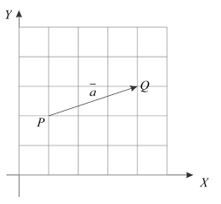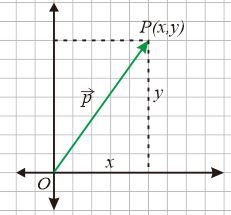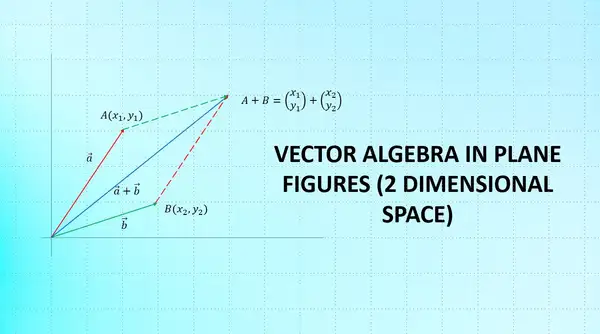A two-dimensional vector is a vector that has two elements, namely vertical (Y-axis) and horizontal (X-axis). Vectors in a flat plane (second dimension) are characterized by the X-axis and the Y-axis, which intersect at the center point O ( 0, 0)
Table Of Contents
A two-dimensional vector is a vector that has two elements, namely vertical (Y-axis) and horizontal (X-axis). Vectors in a plane (dimensional two) are characterized by an X-axis and a Y-axis, which intersect at the center point O (0, 0). Analytically, two-dimensional vectors can be presented according to their elements, namely:
Where x is the horizontal element. When (positive) then x has a direction to the right and when (negative) x has a direction to the left. Next, y is a vertical element. When (positive) then the direction is up and if (negative) the direction is down.
1. Vector Components, Column Vectors, and Row Vectors
Look at the vector in the following image
 In general, the vector in the image above can be written in columns as follows
Apart from column vectors, the vector can also be written as a row vector as follows
In general, the vector in the image above can be written in columns as follows
Apart from column vectors, the vector can also be written as a row vector as follows
is called a column vector and is called a row vector. 3 and 1 are components of the Vector .
A vector depicted on a coordinate plane has a horizontal component (movement to the right/left) and a vertical component (movement up/down). Therefore, vectors can be presented in columns.

2. Position Vector
Position Vector is a vector that begins at the coordinate center and ends at a point . Consider any point and point in the following Cartesian coordinates.
 In the figure above, the vector represents a directed line segment from the origin to the point or vector . Therefore, the vector can be written in column vector form
In the figure above, the vector represents a directed line segment from the origin to the point or vector . Therefore, the vector can be written in column vector form
The vector represents a directed line segment from the origin to the point or vector . The vector can be written as
Now consider the vector . We get the vector by drawing a line from point A to point B. As previously studied, the vector can be expressed in the form of a geometric addition of vectors, namely so
3. Modulus or Vector Size
Modulus states the length or magnitude of the vector. Because the length or magnitude of a vector is always positive, the way to write the modulus uses the absolute sign .
 If the coordinates of the point are known then the length of the position vector is formulated using the Pythagorean theorem or as follows .
If the coordinates of the point are known then the length of the position vector is formulated using the Pythagorean theorem or as follows .
Example 1
Given the vector . Determine the Length of Vector
Alternative solutions
So, the length of vector is 5 units
4. Unit vector
In the previous discussion, the unit vector of the vector was formulated: or
In a column Vector, if then
5. Properties of Column Vector Operations
a. Vector Addition
Analytically, the addition of two vectors can be done as follows
If the two vectors are known to flank a certain angle, then calculations can be used using the cosine rule formula as in trigonometry.

When the angle between and is , then
If vectors are presented in component form (in the Cartesian plane) then addition can be done by adding the components.
For example:
and
= size
Example 2
Given the vector and the vector . Determine the vector sum of !
Alternative Solution
=
Example 3
Given the length of the vector || = 2 and the vector length is || = 4, the angle between vectors and is , then:
b. Vector Reduction
Analytically, if it is known Vector
and then the reduction of two vectors can be formulated
 Example 4
Given the vector and the vector . Determine the vector of !
Example 4
Given the vector and the vector . Determine the vector of !
Alternative Solution
=
c. Scalar Multiplication with Vectors
Multiplying a scalar by a vector will produce a vector with the same direction. The vector is parallel to the vector , written if:
- If , then is the direction of
- If , then is opposite to

Analytically, if we know the vector then , where is a constant.
Example 5
Given and determine !
Alternative Solution
**Example 6**
Determine whether the points P(1, –2), Q(2, 1), and R(4, 7) are collinear (straight).
**Alternative Solutions:**
Points P, Q and R are said to be collinear (in line) if points P, Q and R lie on the same line. Points P, Q and R will lie on the same line if and only if the vectors representing the directed line segments of the points P, Q and R have the same base and are parallel.
The vectors and have the same starting point.
Komponen vektor
Komponen vektor
Two vectors are collinear if there is a number that satisfies and both vectors have the same origin. Because means that the vector is parallel to the vector and both originate at point P. So, it can be concluded that point P, Q and R are points that are collinear (straight).
d. Similarity of two Vectors
Analytically, two Vectors and are said to be equal if and only if and
4. Standard Normal Base
Base definition
If each vector is 1 unit long and perpendicular to each other, then is called standard normal basis in space
Based on this definition, we can conclude that vectors:
and \widehat{j}=\begin{pmatrix}0 \\1 \ \\end{pmatrix} is a standard normal basis in the vector space with and parallel to the X and Y axes respectively
$\widehat{i}=\begin{pmatrix}1 \\0 \\0 \\\end{pmatrix},$ $\widehat{j}=\begin{pmatrix}0 \ \\1 \\0 \\\end{pmatrix}$ and $\widehat{k}=\begin{pmatrix}0 \\0 \\1 \\\end{ pmatrix}$ is a standard normal basis in the vector space $R^3$ with $\widehat{i}$, $\widehat{j}$ and $\widehat{k}$ parallel to the X, Y and Z axes.
Thus, if P is a point (x,y) and O(0,0), then the position vector $\vec{OP}$ can be written as a combination of two basis vectors $\vec{OP}=\vec{p}=\begin{pmatrix}x \\ y \\ \end{pmatrix}=x\begin{pmatrix} 1\\ 0\\ \end{pmatrix}+y\begin{pmatrix} 0\\ 1\\ \end{pmatrix}=x\widehat{i}+y\widehat{j}$
Example 7
Given the triangle OAB with vertices: O(0, 0), A(3, 1) and B(6, 5). $\vec{a}$ is the position vector of point 𝐴 and $\vec{b}$ is the position vector of point 𝐵.
Express the vectors $\vec{a}$, $\vec{b}$ and $\vec{AB}$ in the form of basis vectors.
Alternative solution:
$\vec{a}=x_1\widehat{i}+y_1\widehat{j}=3\widehat{i}+\widehat{j}$
$\vec{b}=x_1\widehat{i}+y_1\widehat{j}=6\widehat{i}+5\widehat{j}$
$\vec{AB}=\vec{b}-\vec{a}=(6\widehat{i}+5\widehat{j})-(3\widehat{i}+\widehat{j})=3\widehat{i}+4\widehat{j}$
Exercise 3
- Look at the vector image on the side:
 Draw a vector:
Draw a vector:- $3.\vec{u}$
- $-2.\vec{v}$
- $\vec{u} + \vec{v}$
- $2.\vec{u} – \vec{v}$
- If it is known that $\vec{u} = \begin{pmatrix} 2 \\ 3 \end{pmatrix}$
and $\vec{v} = \begin{pmatrix}-4 \\ 1 \end{pmatrix}$ determine:
- $\vec{u}$
- $-3.\vec{v}$
- $3.\vec{u} + 2.\vec{v}$
- $2.\vec{v} – \vec{u}$
- Given the vectors $\vec{a} = \begin{pmatrix}2 \\-1 \\\end{pmatrix}$ and $\vec{b} = 2.\vec{a}$ , determine the vector $\vec{c} = \vec{a} + \vec{b}$
- Diketahui vector $\vec{a} = \begin{pmatrix}-2 \\ 4 \\ \end{pmatrix}$, $\vec{b} = \begin{pmatrix} x \\ \ y \\ \end{pmatrix}$ given c = $\begin{pmatrix}3 \\5 \\\end{pmatrix}$. Tentukan x given y if $\vec{c} = \vec{a} + \vec{b}$
- If the vector $\vec{m} = \begin{pmatrix}-8 \\ 4 \\ \end{pmatrix}$ and $\vec{n} = \begin{pmatrix}10 \\ -6 \\ \end{pmatrix}$ determine algebraically the vector of:
- $\frac{1}{2} \vec{m} – \frac{1}{2} \vec{n}$
- $\frac{1}{4} \vec{m} + \frac{1}{2} \vec{n}$
- Given $\vec{a} = \begin{pmatrix} -4 \\-2 \\\end{pmatrix}$ and $\vec{b} = \begin{pmatrix}1 \\ \\\end{pmatrix}$ determine $3\vec{b} – \frac{1}{2}\vec{a}$!
- If $\vec{a} = \begin{pmatrix}2 \\5 \\\end{pmatrix}$ and $\vec{b} = \begin{pmatrix}3 \\- 7 \\ \end{pmatrix}$ determine $2\vec{a} – \frac{1}{2}\vec{b}$!
- If $\vec{p} = \begin{pmatrix}5 \\-3 \\\end{pmatrix}$ and $\vec{q} = \begin{pmatrix}4 \\ -2 \\\end{pmatrix}$ determine $\frac{1}{2}\vec{b} – \frac{1}{2}\vec{q}$!
- If it is known that $\vec{p} = \begin{pmatrix}4 \\-6 \\ \end{pmatrix}$ and $\vec{q} = \begin{pmatrix} x \\ y \\ \end{pmatrix}$ determine x and y if $\vec{p} + \vec{q} = \begin{pmatrix} -2 \\ -3 \\ \end{pmatrix}$!
- If $\vec{a} = \begin{pmatrix}a_1 \\a_2 \\\end{pmatrix}$ and $\vec{b} = \begin{pmatrix}-9 \\ 2 \\\end{pmatrix}$ determine $a_1$ and $a_2$ if $\vec{a} – \vec{b} = \begin{pmatrix}4 \\7 \\\end {pmatrix}$!


 Draw a vector:
Draw a vector: